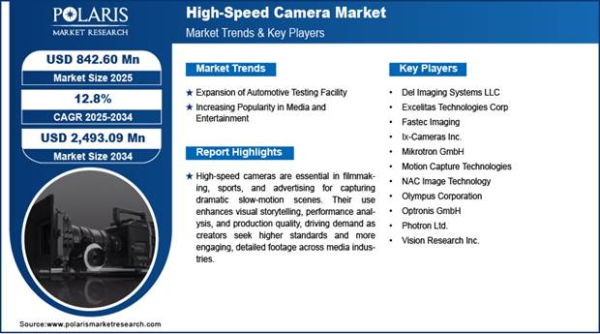Ever wondered what it takes to freeze a hummingbird’s wings mid-flight or capture the exact moment a balloon bursts into a thousand droplets? High-speed cameras unlock a world that moves too fast for the naked eye, where every split-second tells a story, and milliseconds matter. In this fast-paced dive, we explore the technology that turns fleeting moments into unforgettable visuals.
Did you know that the global high-speed camera market was valued at USD 748.95 million in 2024 and is projected to register a CAGR of 12.8% from 2025 to 2034.
What is a High-Speed Camera?
A high-speed camera is a specialized device designed to capture extremely fast events by recording at exceptionally high frame rates, often thousands or even millions of frames per second. High-speed cameras can capture rapid motion with incredible clarity, making them essential tools in fields such as scientific research, sports analysis, manufacturing, and cinematography.
How High-Speed Cameras Work?
High-speed cameras operate by capturing a massive number of frames per second, far beyond the capabilities of standard cameras. At the core of this technology is a highly sensitive image sensor that can rapidly convert light into electronic signals, paired with a powerful processor and high-bandwidth memory to handle the enormous data flow. These cameras use extremely fast shutter speeds to eliminate motion blur, often requiring intense lighting to ensure image clarity. The higher the frame rate, the lower the resolution tends to be, making it a constant balancing act between speed and image quality. This precise engineering allows high-speed cameras to freeze even the fastest movements, making the invisible visible.
Applications Across Industries
High-speed cameras have transformed the way we observe, analyze, and interpret fast-moving phenomena. From science labs to sports arenas, these powerful imaging tools are revealing what once went unseen.
Scientific Research
In fields such as physics, biology, and engineering, high-speed cameras enable researchers to observe and analyze rapid processes, including chemical reactions, fluid dynamics, and microscopic movements. For example, in crash tests and biomechanics, they provide crucial insights for safety innovations and medical advancements.
Manufacturing and Industrial Inspection
High-speed imaging plays a vital role in quality control and fault detection on production lines. By capturing high-speed processes, such as the movement of robotic arms, packaging systems, or material stress tests, manufacturers can detect defects, prevent failures, and optimize operations with pinpoint accuracy.
Media and Entertainment
From breathtaking slow-motion scenes in blockbuster films to capturing dramatic sports moments in commercials, high-speed cameras add a cinematic edge. They help directors and content creators visualize motion with incredible detail, turning ordinary moments into mesmerizing visual experiences.
Sports and Athletics
Athletes and coaches utilize high-speed cameras for performance analysis, breaking down rapid movements such as a golf swing or a sprinter’s stride. This enables fine-tuning techniques, prevents injuries, and enhances overall athletic performance through visual feedback.
Defense and Aerospace
In the defense and aerospace sectors, high-speed cameras are used to study ballistics, explosions, and aerodynamics. Whether analyzing missile launches or testing the structural integrity of aircraft components, these cameras provide critical data in high-risk environments.
The Rising Demand for High-Speed Cameras
- Advancements such as back-side illuminated sensors and global shutters have significantly enhanced image clarity while minimizing distortion. As these technologies become increasingly affordable and accessible, more industries are embracing high-speed imaging solutions, thereby further accelerating the growth of the high-speed camera market.
- High-speed cameras are extensively used in filmmaking, sports broadcasting, and advertising to produce striking slow-motion visuals. They capture moments that standard cameras can’t, making them ideal for action-packed movie scenes, dynamic product commercials, and detailed nature documentaries.
Future of High-Speed Imaging
The future of high-speed imaging is set to be faster, smarter, and more accessible. Emerging trends indicate the integration of artificial intelligence and real-time data analysis, enabling the instant interpretation of high-speed footage. Advances in sensor technology and miniaturization are paving the way for compact, portable high-speed cameras that can be used in remote or mobile applications. Additionally, as these systems become more cost-effective, industries like healthcare, autonomous vehicles, and robotics are expected to adopt high-speed imaging for precision diagnostics and intelligent automation. With continuous innovation, high-speed cameras are poised to become a vital component of next-generation technology across various sectors.
Final Thoughts
In conclusion, high-speed cameras have revolutionized the way we capture and analyze fast-moving phenomena, offering an unprecedented level of detail and clarity. From scientific research to sports, entertainment, and industrial applications, their ability to freeze time and reveal hidden moments has unlocked a new world of possibilities. As technology continues to advance, high-speed imaging will only become more powerful, accessible, and integrated into a wide range of industries, driving innovation and enhancing our understanding of the world around us. The future of high-speed cameras is bright, with new horizons waiting to be explored.


















